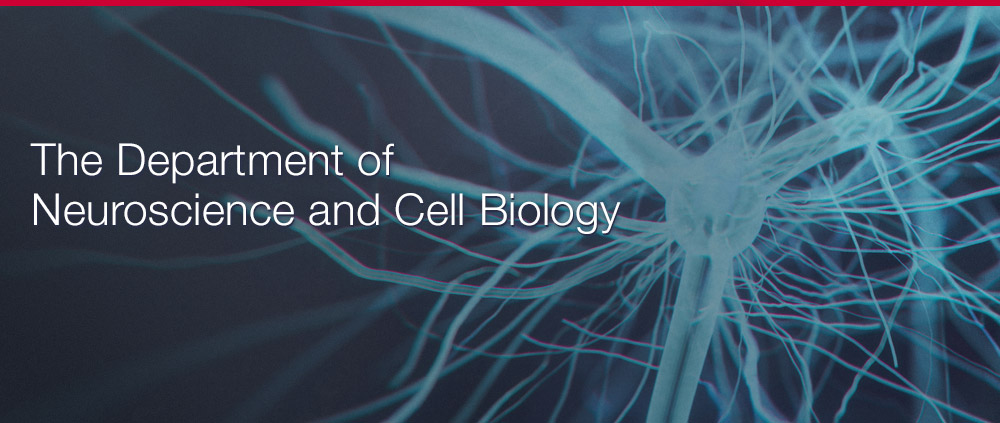-
About RWJMS
- Departments / Institutes
- Alumni
- Make a Gift

Ruifeng Ray Cao, MD, PhD

Associate Professor
Department of Neuroscience and Cell Biology
PhD, Ohio State University
Postdoc, McGill University
Phone: (732) 235 4071
Email: ruifeng.cao@rutgers.edu
Office: Research Tower, Room 349, 675 Hoes Lane, Piscataway, NJ 08854
Lab: Research Tower, Room 308,335, 675 Hoes Lane, Piscataway, NJ 08854
Ray Cao Lab Website
Research Interests:
Circadian rhythm, translational control, neuropsychiatric disorders
Circadian (~24 h) rhythmicity is an evolutionarily conserved property that regulates fundamental biological processes. Rhythmic gene expression is found in a variety of cells and tissues. In mammals, the master pacemaker is located in the suprachiasmatic nucleus (SCN) of the hypothalamus. The SCN relays photic information from the retina to the brain to synchronize endogenous rhythms to ambient light/dark cycles. Disruption of the circadian rhythm and body clock function is associated with many human diseases.
We are interested in mRNA translational control mechanisms that regulate the functions of the circadian clock and how dysregulated translational control is involved in circadian dysfunction in neurological and psychiatric diseases. We are particularly interested in the role of the mammalian target of rapamycin (mTOR) signaling and integrated stress response as the coupling mechanisms between cell metabolism and the circadian clock. We constantly look for talented and motivated undergraduates, graduate students, and postdoctoral researchers to join us.
Research Techniques:
Our laboratory utilizes a combination of molecular, cellular, and behavioral technologies, including polysome profiling, RNA sequencing, qRT-PCR, Western blotting, immunocytochemistry, electrophysiology, confocal microscopy, viral-mediated gene silencing and animal behavioral analysis (e.g., circadian, social and memory tests, EEG). A variety of model systems, including cell culture, organotypic slice culture, and whole animals (transgenic and knockout mice) are employed.
Selected Publications:
For complete list, click here.
* Indicating trainees from the Cao Lab
1. Singla R*, Mishra A*, Cao R (2022). The crosstalk between mammalian target of rapamycin (mTOR) signaling and the circadian clock and its implications in psychiatric disorders. Transl Psychiatry, 12(1):355. doi: 10.1038/s41398-022-02120-8. PMID: 36045116.
2. Liu D*, Nanclares C, Simbriger C, Fang K, Lorsung E*, Amorim IS, Chalkiadaki K, Pathak SS*, Li J*, Gewirtz JC, Jin VX, Kofuji P, Araque A, Orr HT, Gkogkas CG, Cao R (2022). Autistic-like behavior and cerebellar dysfunction in Bmal1 mutant mice ameliorated by mTORC1 inhibition. Mol Psychiatry, doi: 10.1038/s41380-022-01499-6. PMID: 35301425
3. Pathak SS*, Liu D*, Li T, de Zavalia N, Zhu L, Li J*, Karthikeyan R*, Alain T, Liu AC, Storch KF, Kaufman RJ, Jin VX, Amir S, Sonenberg N, Cao R (2019). The eIF2α Kinase GCN2 Modulates Period and Rhythmicity of the Circadian Clock by Translational Control of Atf4. Neuron,104(4):724-735. PMID: 31522764
4. *Liu D, Stowie A, de Zavalia N, Leise T, Pathak SS*, Drewes LR, Davidson AJ, Amir S, Sonenberg N, Cao R (2018). mTOR signaling in VIP neurons regulates circadian clock synchrony and olfaction. Proc Natl Acad Sci U S A,115(14): E3296-E3304.PMID: 29555746
5. Cao R, Gkogkas C, de Zavalia N, Blum ID, Yanagiya A, Tsukumo Y, Xu H, Storch KF, Liu AC, Amir S, Sonenberg N (2015). Light-regulated translational control of circadian behavior by eIF4E phosphorylation. Nat Neurosci, 18(6):855-62. PMID: 25915475
6. Cao R, Robinson B, Xu H, Gkogkas C, Khoutorsky A, Alain T, Yanagiya A, Nevarko T, Liu AC, Amir S, Sonenberg N (2013). Translational control of entrainment and synchrony of the suprachiasmatic circadian clock by mTOR/4E-BP1 signaling. Neuron, 79(4):712-724. PMID: 23972597
7. Cao R, Li A, Cho HY, Lee B, Obrietan K (2010). mammalian target of rapamycin signaling modulates photic entrainment of the suprachiasmatic circadian clock. J Neurosci, 30(18): 6302-6314. PMID: 20445056